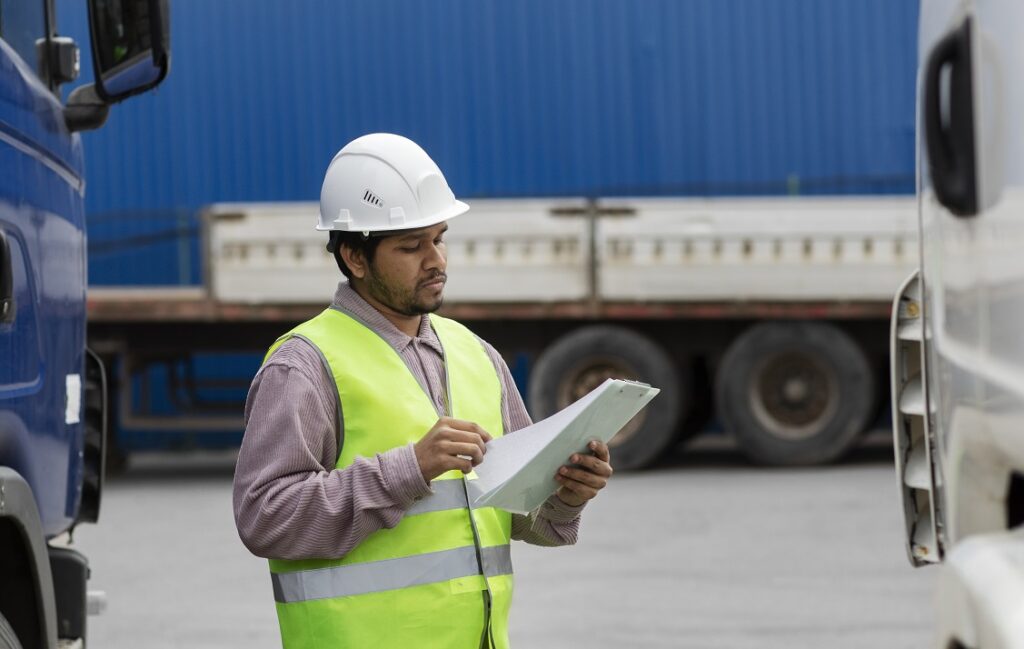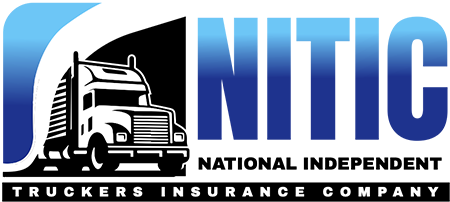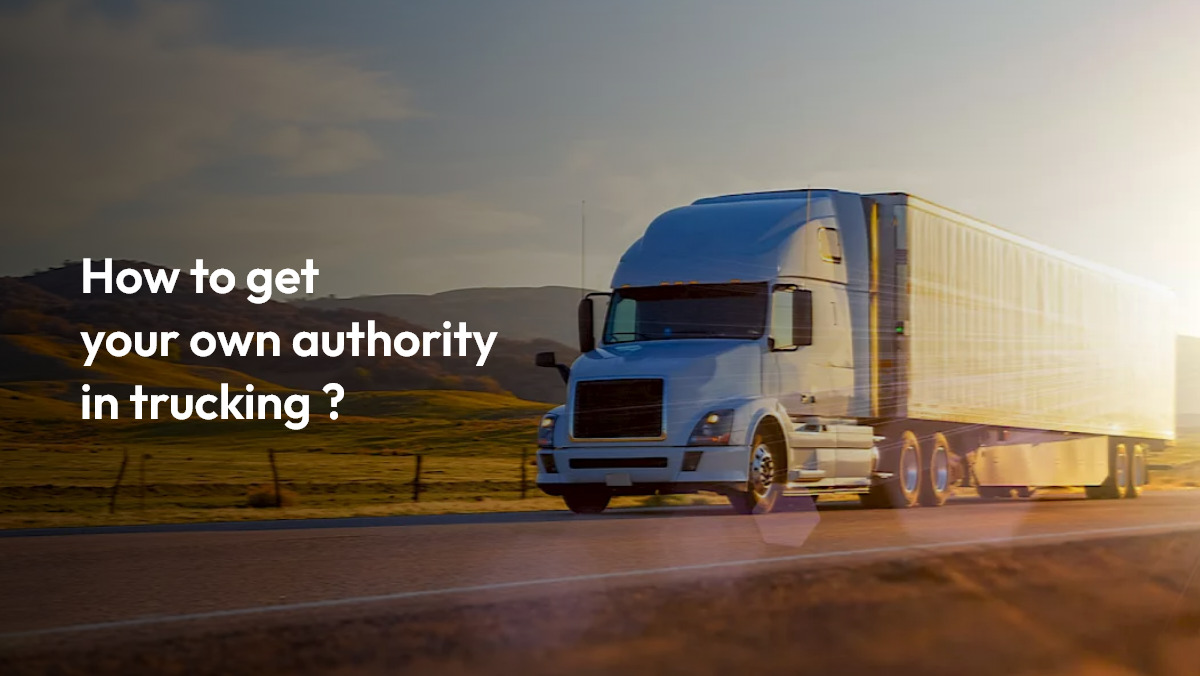How to Get Your Own Authority in Trucking?
There is a significant difference between working under someone’s authority as an independent truck driver and having your own truck authority. What does that mean?
When you work as a truck owner-operator, or earching for a driver class c jobs, you get paid by the government for hauling goods. And according to FMCSA, this authority varies depending on several factors, including the type of cargo you haul, the mode of commerce (interstate or intrastate), truck model, and others.
As fascinating as it sounds to be your own boss, getting truck operating authority takes work. You must go through several steps, with significant funds in your bank account, verification of your previous record, and other minute details.
With so much conflicting information available online, it can be difficult to find the correct one. Thus, to assist you in your truck owner-operator journey, we have compiled a comprehensive guide that covers everything from the steps to creating your business entity, such as a sole proprietorship or a limited liability company, to the total time required, to the average cost.
So, continue reading to learn more.
Table of contents
How does the FMCSA authority operate?
The Federal Motor Carrier Safety Administration, or what we know as FMCSA, issues different operating authority numbers depending on the operation the company wants to run and the cargo it hauls. And these operating authorities are identified as follows in different scenarios:
- MC, or Motor Carrier Number
- FF, or Freight Forwarder Number
- MX, or Mexico Number
For instance, trucking companies that do operate in the following types of transportation for a fee or compensation (direct or indirect) require an MC number in addition to a DOT number:
- Interstate transport of passengers in commerce.
- Haul government-regulated goods owned by others or arrange for their transit of items.
Moreover, contrary to the USDOT number, a trucking company may require multiple operating authorities to sustain its business.
Types of Trucking Operating Authority


Choosing the right operating authority is crucial for your business as it will further affect the types of insurance required by the FMCSA. Below are the different types of interstate operating authorities for motor carriers as per the OP-1 filing system:
Motor Carrier of Property
Getting your Motor Carrier of Property authority is a crucial step when entering the world of trucking. This type of authority allows for-hire carriers to transport regulated property for the public, excluding household commodities. Regulated property typically encompasses a wide range of goods and materials, and it’s important to note that household commodities are not covered under this specific authority.
To obtain this authority, one of the primary requirements is to secure primary public liability coverage, which includes coverage for bodily injury and property damage. This insurance is essential to protect not only your business but also the general public in case of accidents or incidents involving your commercial vehicles. This coverage ensures that you are financially responsible for any harm or damage that may occur during your transportation operations, providing peace of mind for both you and your customers.
It’s important to emphasize that while primary public liability coverage is mandatory, cargo coverage is not required for this specific authority. Cargo coverage typically safeguards the goods being transported, but for Motor Carriers of Property, the focus is primarily on liability for injury or damage to third parties.
Obtaining your own authority in trucking can be a complex process, but understanding the specific requirements, such as the need for primary public liability coverage, is crucial for success in this industry. By meeting these requirements and effectively managing your operations, you can navigate the trucking world with confidence and ensure that you are compliant with the necessary regulations to operate as a for-hire carrier of regulated property.
Motor Carrier of Household Goods:
In the dynamic world of trucking, one essential step towards building a successful independent trucking business is obtaining your Motor Carrier of Household Goods authority. This authority empowers carriers to specialize in transporting household commodities, which encompass a wide array of items used for personal purposes. From furniture and electronics to clothing and kitchen appliances, these goods hold great significance in the lives of the public.
What sets Motor Carriers of Household Goods apart is their commitment to providing a comprehensive service. Beyond the typical transportation of goods, they often go the extra mile by offering services like loading and unloading cargo directly at the customer’s home. This additional level of service can be a game-changer, as it saves customers time and effort, making the moving process smoother and less stressful. Moreover, some HHG carriers even offer inventorying services, ensuring that every item is accounted for during the transportation process, which adds an extra layer of peace of mind for both the carrier and the customer.
However, it’s important to note that obtaining Motor Carrier of Household Goods authority comes with certain responsibilities and requirements. One of the foremost requirements is the need for comprehensive insurance coverage. This includes primary public liability coverage, which encompasses both bodily injury and property damage. Accidents can happen in the trucking industry, and this coverage is vital to protect your business and the public in case of unforeseen events. Additionally, cargo coverage is essential to safeguard the valuable household goods you transport. It provides financial protection in case of damage or loss of the cargo during transit, ensuring that you can compensate your customers for any unforeseen mishaps.
In conclusion, acquiring your own authority as a Motor Carrier of Household Goods is a significant step in establishing a reputable and successful trucking business. By specializing in the transportation of personal goods and offering additional services such as loading, unloading, and inventorying, you can distinguish yourself in the competitive trucking industry. Just remember that with great authority comes great responsibility, and ensuring you have the proper insurance coverage is paramount to protect your business and provide peace of mind to your customers.
Property Broker:
When delving into the world of trucking and aspiring to gain your own authority, it’s essential to grasp the distinct roles and responsibilities within the industry. One critical distinction to be aware of is the role of Property Brokers, which plays a crucial part in the transportation of goods. Property Brokers primarily operate in two categories: one for general property and another specifically for household goods.
Property Broker for General Property (Excluding Household Goods):
In this category, carriers are tasked with transporting property owned by others in exchange for compensation. However, it’s essential to note that this category specifically excludes the transportation of household goods. While carriers under this classification are responsible for the safe and efficient transportation of various types of property, the Property Broker itself does not assume liability for property damage during transit. Instead, they facilitate the connection between shippers and carriers, ensuring that the cargo reaches its destination intact.
Property Broker for Household Goods:
Conversely, the category dedicated to household goods entails carriers transporting items owned by others, but in this case, the cargo consists of household goods. This includes personal belongings, furniture, and other domestic items. Like the previous category, Property Brokers in this domain do not bear responsibility for property damage during transit. Their primary role revolves around coordinating the transportation of household goods, connecting shippers with carriers, and ensuring that these cherished possessions reach their destination safely.
Understanding the roles of Property Brokers in trucking is pivotal, especially when considering gaining your own authority. As you navigate the intricate world of trucking regulations and responsibilities, it’s crucial to have a comprehensive understanding of the nuances between these two categories, allowing you to make informed decisions when venturing into this dynamic industry.
United States-based Enterprise Carrier of International Cargo
(Except for household items): A business with its headquarters in the US that carries international cargo (except home items) but is held or managed (to a greater extent than 55%) by a resident alien or native of Mexico. International freight must come from or be going to another country.
(For household goods): A business with its headquarters in the US that carries international household commodities but is held or managed (to a greater extent than 55%) by a resident alien or native of Mexico.
In addition to the aforementioned, there are more authorities, including Freight Forwarders, Non-North America-Domiciled Motor Carriers, and Mexican-based carriers (operating outside of commercial US zones across US-Mexico borders).
What is the cost of filing your own authority?
The federal department charges a filing commission for each authority, and it is non-refundable. So, pay attention to detail and avoid making mistakes.
Following are the filing fees of authority as per the action:
- $300.00 for Permanent Authority
- $14.00 for Notice of Name Change
- $80.00 for Reinstate Authority
How to apply for your own trucking authority?
Having your own trucking authority means you get paid by the government for every single transport. This gives you the potential to work for yourself and earn more. However, there are some mandatory steps to follow in order to get a trucking authority, which is as follows:
Register your trucking business
For first-time applicants who have never registered with FMCSA and do not carry a USDOT number, they must first register their trucking company with the URS (Unified Registration System). Here, you can choose your business entity, such as a sole proprietorship or a limited liability company. You also need to use logo maker for creating your own logo design. If you are interested in limited liability, then you will require to get the EIN (Employer Identification Number) that is issued by the IRS (Internal Revenue Service) administrators.
Once your registration is complete, FMCSA will publicly display information such as your registered name, address, and phone number as per state policy. So, if you receive a call from telemarketers or automated calls claiming to be from the FMCSA, don’t fall for it. Stay away from such calls, and if possible, report the number.
Get the USDOT Number
The US Department of Transportation, or USDOT, number serves as a unique identifier for trucking businesses in order to monitor their activities, especially in the event of auditing, safety compliance, or accident investigations.
All the companies involved in the following trucking operations must have a USDOT number:
- Transporting passengers via commercial trucks (interstate).
- Transporting cargo via commercial trucks (interstate).
- Transporting hazardous cargo via commercial trucks (intrastate). In such a case, an additional safety permit is required.
Every time you update your business’s information, your DOT number is renewed.
Furthermore, as you navigate the process of obtaining your own trucking authority, it’s essential to consider the increasing demand for skilled truck drivers in the industry, making this a timely opportunity for those looking to pursue a rewarding career on the road.
NITIC can help you get USDOT number. Contact us Today or Call 800-726-8376
Apply for the authority
As stated earlier, an MC (Motor Carrier) number is required for interstate and intrastate commerce. Applicants who have already obtained a USDOT number can now file for additional authority based on the relevance of their business operations.
This whole process goes online via the FMCSA legacy registration system, where you apply using a credit card/ check, and forms. To pace up the process, it is wise to send the credit card via US mail and email all the necessary information to the Federal Motor Carrier Safety Administration. The other way (via check) will delay your processing time by 6-8 weeks (not advisable).
Required Forms
BOC-3 Form: According to federal regulations in the United States, all transport companies that want to get their own operating authority must assign a designated process agent in every state. This agent will complete all the necessary paperwork on behalf of the carrier.
If you are a motor carrier, only the process agent can file the BOC-3 form. But for a freight forwarder or broker who does not work in commercial transportation, you can fill out the form on your own.
Once you are done with the BOC-3 filing and have properly mailed it electronically to the FMCSA, they will issue an MC number. However, it takes 3-4 business days to receive the operating authority documents. In this case, if it exceeds more than 10 days from the issued date, you may contact their helpline number 800-832-5660.
OP-1 Form: OP-1 form is not for first-time applicants. For them, the process is the same, i.e., through the URS. For those who are looking for additional authorities, the OP-series form is required.
MCS-150 Form: If you are looking to update your USDOT number, then you need to file the MCS-150 form. This is essential because it keeps the FMCSA authorities in sync with your company’s information in order to tally later in case of safety compliance, an accident, or accountability.
Get your UCR Permit
Unified Carrier Registration, or UCR, is a federal program that replaces the Single State Registration System (SSRS). As per UCR, every trucking company that is involved in interstate transportation has to pay an annual registration fee.
Following are the scenarios where a motor carrier, freight forwarder, broker, or truck leasing company needs to get the UCR permit:
- If transporting cargo weighh more than 10,000 pounds
- If transporting more than 10 passengers (including the truck driver).
- If hauling cargo involves hazardous materials.
- If the motor carriers are from Canada or Mexico and are transporting across interstate and international boundaries in the US.
Pay HVUT (Heavy Vehicle Use Tax)
Heavy Highway Vehicle Use Tax return or form 2290 is mandatory to file if the registered motor vehicle in your name under State/ Mexican/ Canadian carries weight equal to or exceeds more than 55,000 pounds. The taxation period is between July 31- June 30 every year.
Register for IRP (International Registration Plan)
The International Registration Plan or IRP is an agreement that is required for a trucking company that is involved in transportation between interstates, Washington, and Canada. The perk of IRP is that it gives each registered motor carrier a plate and a cab card that are valid across these borders at certain weights. Additionally, you can renew your plate at any time and manage certain transaction types, including adding trucks or states and transferring plates.
To get an IRP, you need to register all your commercial trucks, including their model number, purchase cost, and date. After the payment processing, you will get the tags.
Setup an IFTA account
After registering for an IRP account, you can further apply for an IFTA (International Fuel Tax Agreement) license, which is an agreement between the 48 states of the US and the 10 provinces of Canada.
Earlier, truck drivers needed to get a separate fuel permit for a particular location, which actually used to bury them in lots of paperwork reporting every single detail from location to filing. However, all of this can be avoided by obtaining a single fuel permit and opening an IFTA account. With an IFTA return, you just need to submit one fuel return to your base authority quarterly.
Apply for drug and alcohol test
And finally, FMCSA and USDOT require all trucking companies to pass a drug test before they hire drivers or drive themselves. So, make sure your drivers have a clean past driving record, have logged considerable driving hours, and have no accidental records. There is a whole list of rules and regulations mentioned on the FMCSA website regarding drug tests.
How do you check your application status?
To check your motor carrier status, follow the following steps:
- Visit the SAFER website.
- tab on the “Licensing and Insurance” section under the FMCSA search.
- Enter your USDOT number and MC number and click “search.”
- Scroll down and check your operating authority’s history.
Who does not require operating authority?
Running a trucking business under your own operating authority is a liability in itself. While transporting cargo across interstate or international borders, there is a certain level of financial risk associated with it, making an adequate level of insurance required. However, there are scenarios where a motor carrier does not require an operating authority, and these are the following:
- Private carriers that haul their own cargo.
- For-hire carriers that don’t haul federally regulated goods.
- Motor carriers operating within a federally designated commercial zone are not subject to interstate rules and regulations.
NITIC is here for you!
In conclusion, obtaining your own trucking authority is a significant step towards becoming an independent truck driver and entrepreneur in the world of trucking. While it may seem like a complex process with various requirements and responsibilities, it opens up doors for you to work for yourself and potentially earn more in the industry.
To ensure a smooth transition and compliance with all necessary regulations, it’s crucial to follow the steps outlined in our comprehensive guide. From registering your trucking business to obtaining the USDOT number, filing for the authority, and meeting insurance and safety requirements, each step plays a vital role in your journey.
At NITIC (National Independent Truckers Insurance Company), we understand the unique needs of independent truckers and can assist you in obtaining the necessary insurance coverage for your trucking business. Whether you are a Motor Carrier of Property, Motor Carrier of Household Goods, or fall into any other category, our team is here to help.
If you’re ready to take the next steps in gaining your own trucking authority or have questions about insurance coverage, don’t hesitate to reach out to NITIC. Contact us today at 800-726-8376 to discuss your independent trucking insurance needs. Your success as an independent truck driver is our priority, and we’re here to support you every step of the way.






